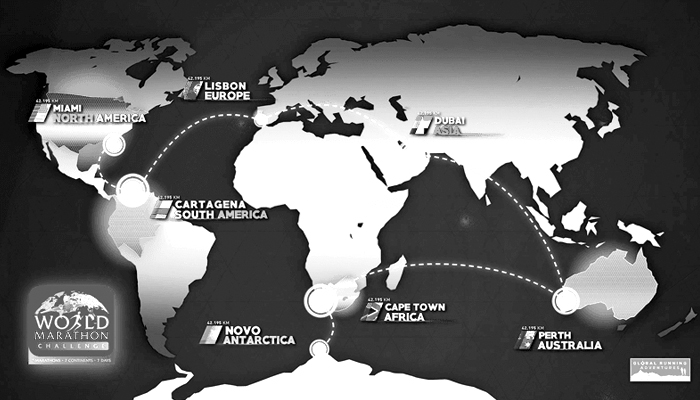

It’s all becoming very real now. On January 30, in Antarctica, I will toe the start line of the World Marathon Challenge ‑ the first of 7 consecutive marathons that will take me around the world.
Aside from the physical and mental training, running 7 marathons in 7 days on 7 continents does require a lot of logistical planning: what to wear, how to hydrate, fuel myself, and recover efficiently and sufficiently to run 26.2 miles every 24 hours or so.
Here’s a rundown of some items, I’ll pack for my adventure:
When it comes to what I will wear, shorts and singlet should be sufficient in five of the locales. Lisbon, Portugal should be cooler, so I’ll have a shirt with sleeves on hand. For Antarctica, I’ll wear an Under Armour base layer, North Face Summit Series jacket, warm running gloves, a balaclava mask/hat that only exposes my eyes, plus a neck warmer. We’ve been told to expect around 14 degrees Fahrenheit — not as cold as you might think. And, despite the temperatures, I will surely still sweat, so I plan to change my base layer mid-race, since a big factor to staying warm is staying dry. Also, I will wear different running shoes in Antarctica — Saucony Peregrine Ice shoes with minimalist Vibram soles.
Here are a few other things I’ll pack:
Compression socks – I have various kinds of socks that help me feel more supported and stable — some come up to my knees, others are calf sleeves to wear with shorter running socks. I also have some that are tighter and give greater compression for when I am jumping on an airplane right after a race, as blood can easily pool in the lower extremities while sitting in the same position for a long period.
RockTape – RockTape is a kinesiology tape that interferes with pain signals being directed to the brain while decompressing an area of swelling and inflammation. I’ve used it for the first time this year, and it works for me. I’ll apply it to my lower back and ankles — places I can be prone to pain.
Rapid Reboot – These pneumatic compression boots are a sort of an inflatable sleeve that goes around the legs and connects to an air pump that pressurizes and then releases different sections of the legs according to different programs and durations. It has the effect of helping the body rid itself of the lactic acid that builds up as a by-product of very long endurance sessions.
Rollers – These are a standard item in every runner's arsenal. You use your body weight to stretch the muscles and work out the kinks. I have a vibrating roller and a vibrating ball. Both have rechargeable batteries and can operate at varying degrees of intensity. They are extremely effective for getting into smaller places, working the IT band and the whole Achilles area. They are critical during my hour-long recovery routine after a race.
Typically in races, I don’t carry my own hydration — I just rely on the aid stations on the course. While the World Marathon races will be supported like any other race, I plan on getting ahead of the hydration game before the next day’s race. For that reason, I’ll run with a CamelBak — a sort of backpack that holds a couple of liters of liquid I can sip from. I’ll be drinking every half mile and taking the opportunity to shake out my shoulders and look at the horizon in an attempt to correct my form and keep from slouching.
A marathon burns about 3,000 calories, and I need 2,000 just for everyday life. That means I need to consume 5,000 calories per day, which is not a massive amount.
During the races, there will be nutrition on the course, but I plan to rely on my own, since certain brands are tried and true for me. I will consume about 10 fuel gels each race.
Between races, the organizers will supply meals. We’ve received menus ahead of time, and the options are generally plant based, which I’m accustomed to. I’m not too concerned, otherwise, about food intake. I’ll be running more moderate paces, so I don’t anticipate the GI issues that can crop up when racing all out.
I do plan to ingest curcumin, a member of the ginger family that is better known as ground turmeric root. It has been used for culinary and medicinal purposes for centuries. It has very strong anti-oxidative and anti-inflammatory properties and can be ingested in pill form, so that I don’t have to rely on NSAIDS (e.g. Motrin), which have very undesirable side effects associated with long-term use.
Things will get underway when I fly from Washington, D.C., to Cape Town on January 25. That will allow me to get acclimated to the time zone and do some sightseeing before I attend pre-departure briefings with the organizers on January 29.
On January 30, we will board a charter flight to Antarctica, and our itinerary will be as follows:
Jan. 30: Antarctica: Marathon in Novo, Antarctica
Jan. 31: Africa: Marathon in Cape Town, South Africa
Feb. 1: Australia: Marathon in Perth, Australia
Feb. 2: Asia: Marathon in Dubai, UAE
Feb. 3: Europe: Marathon in Lisbon, Portugal
Feb. 4: South America: Marathon in Cartagena, Columbia
Feb. 5: North America: Marathon in Miami, USA
When it is all over, I and my fellow participants (53 in all) will have run 183.4 miles (295.15 km) over 7 days and flown 27,894 miles (44,893 km) — spending a total of 61 hours in the air.
Each race venue will be special in its own way. Antarctica will be unlike anything else. Cape Town is one of the world’s great cities. Dubai is an iconic city. I have never been to Australia or Cartagena. I’ve been to Lisbon before and look forward to returning. And Miami will be like coming home. I can’t wait to get started.
To donate towards his mission to improve access and care for pediatric and adolescent mental health, please go here. Jonathan has been in the media, doing interviews on NPR, local TV and more to talk about his upcoming adventure and his mission. Visit this page to watch and listen.
Never miss a post. Get Risky Business tips and insights delivered right to your inbox.

Jonathan Terrell is the Founder and President of KCIC. He has more than 30 years of international financial services experience with a multi-disciplinary background in accounting, finance and insurance. Prior to founding KCIC in 2002, he worked at Zurich Financial Services, JP Morgan, and PriceWaterhouseCoopers.
Learn More About Jonathan